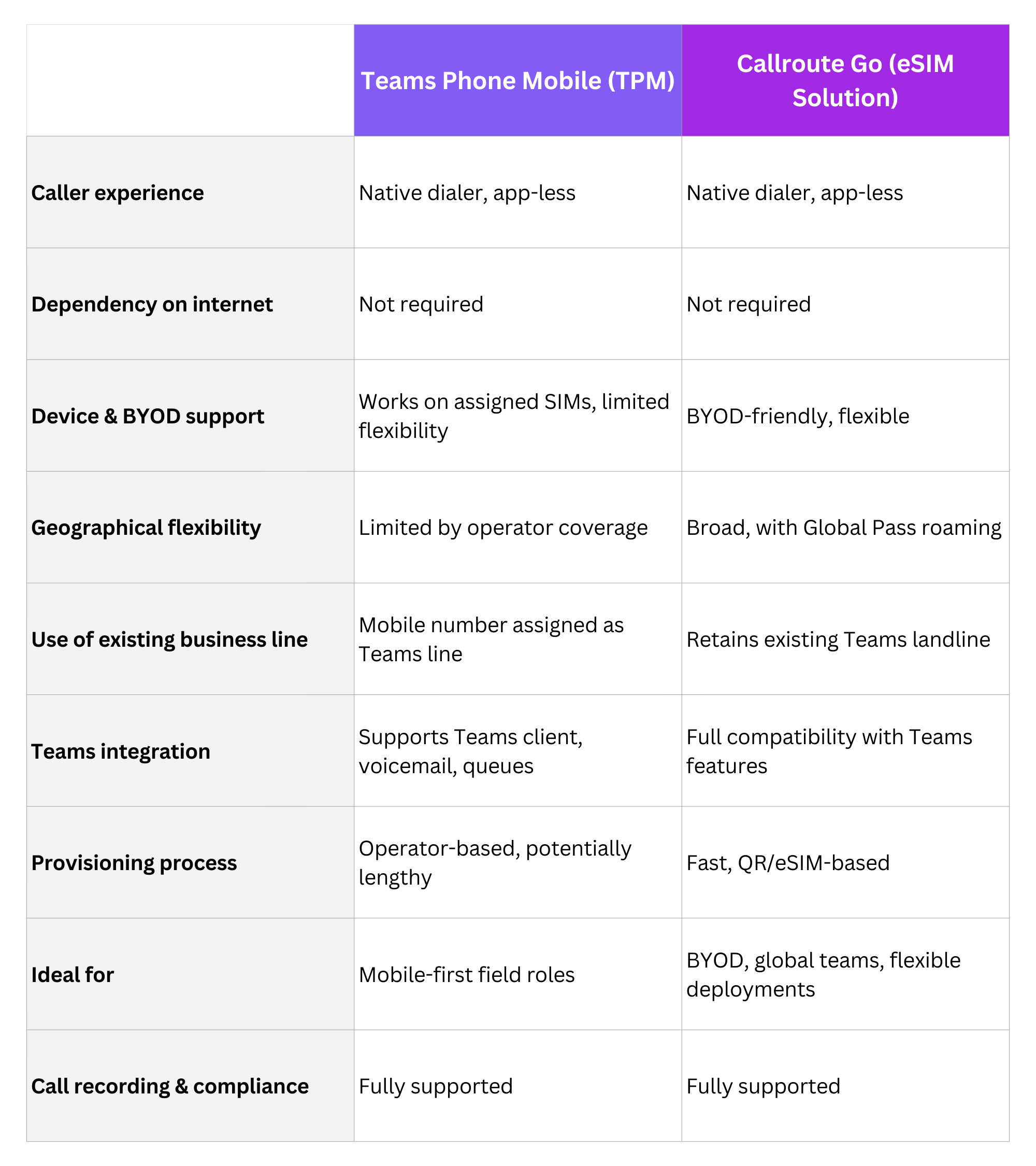
Teams Phone Mobile vs eSIM Solutions: An Enterprise IT Admin’s Cribsheet
Automate Microsoft Teams provisioning using Callroute's self-service portal.
Don’t make a move before reading this guide. Microsoft teams phone mobile vs eSim: the ultimate enterprise IT cribsheet for choosing the right solution
Microsoft Teams now plays a major role in enterprise telephony. IT administrators, especially in large organizations, face a choice between two mobile voice strategies:
Teams Phone Mobile (TPM) and eSIM‑enabled solutions.
This guide breaks down who each is best suited for and how they differ.
What’s Teams Phone Mobile (TPM)?
Teams Phone Mobile (TPM) is Microsoft’s fixed-mobile convergence solution that integrates a user’s mobile number directly into Microsoft Teams. By partnering with select mobile network operators, TPM enables a mobile number to act as the user’s Teams number — working seamlessly across both the native dialer and the Teams client.
How TPM typically works:
An enterprise procures Teams Phone Mobile numbers through an approved carrier.
The mobile number is assigned to the user’s Teams account.
Calls made to the mobile number will ring both in the native dialer and in the Teams app, and outbound calls can display the Teams identity.
Key benefits of Teams Phone Mobile:
Native dialer integration: Users can make and receive calls from their mobile device without relying solely on the Teams app.
Improved reliability: Calls can connect via the GSM mobile network, reducing dependency on mobile data or Wi-Fi.
Compliance-friendly: Voice traffic can be integrated into Teams call recording, logging, and governance policies.
Consistent user identity: The same number is presented whether a call originates in Teams or from the mobile dialer.
Considerations:
Carrier dependency: Availability is limited to mobile operators partnered with Microsoft, which may restrict choice across regions.
Procurement model: Requires corporate mobile contracts, which may not suit BYOD environments.
Scalability: Large rollouts depend on operator coverage and onboarding processes, which can take time.
What Are eSIM-Based Solutions?
eSIM (embedded SIM) technology allows a user to activate a business mobile number digitally, without needing a physical SIM card. For enterprises using Microsoft Teams, eSIMs can be provisioned to deliver a dedicated business line on an employee’s existing device, often alongside their personal number.
How eSIM solutions typically work:
The eSIM is delivered digitally (often via a QR code).
The user downloads the profile to their device and can immediately start using their Teams number for work.
When a call comes in, or the user needs to make a call, they can select which number they want to answer/call from.
Key benefits of eSIM solutions:
Dual-line capability: Users can keep personal and business identities separate on one device.
BYOD-friendly: No need to issue corporate phones; employees can add their business line to their own device.
Global flexibility: eSIMs can be provisioned quickly in multiple geographies, ideal for distributed teams.
Fast deployment: Teams numbers can be used on devices instantly rather than waiting for physical SIMs to ship.
Reduced hardware costs: No requirement to maintain large corporate handset estates.
Considerations:
Device compatibility: Not all handsets (especially older ones) support eSIM.
User adoption: Staff may need guidance on installing and using eSIM lines.
App vs. native experience: Depending on the solution, some calls may still require the Teams client rather than the native dialer.
At-a-Glance Comparison

When to Choose Each
Choose Teams Phone Mobile (TPM) when:
You need tight compliance controls with call recording and governance built into Teams.
Your organization provides corporate-owned mobile devices to employees.
You operate primarily in regions where TPM operator coverage is strong.
You want the most seamless end-user experience with native dialer integration.
Choose eSIM solutions when:
Your workforce is globally distributed and needs local numbers in multiple countries.
You support BYOD models, avoiding the cost and logistics of issuing second devices.
You need rapid provisioning that can scale up or down in days rather than weeks.
You want flexibility to add or remove lines without being tied to specific carriers.
For many large enterprises, the reality is that both TPM and eSIM can play a role in a Microsoft Teams telephony strategy. TPM is often best suited to compliance-heavy, corporate-liable mobile estates, while eSIM is more adaptable for global, flexible, and BYOD-driven environments.
The key for IT leaders is understanding where each fits and aligning them to the right user profiles:
TPM → Knowledge workers, regulated industries, corporate device fleets.
eSIM → Distributed teams, contractors, roaming users, BYOD models.
The CallrouteGo Advantage
If you’re exploring eSIM for Microsoft Teams, CallrouteGo by Callroute provides a simple, scalable way to deploy and manage it.
Fast provisioning: Issue Teams-ready eSIMs instantly via QR code. No shipping delays.
BYOD-friendly: Add a secure business line to personal devices without issuing extra hardware.
Global coverage: Enable staff to roam across multiple countries with a single eSIM solution.
Tightly integrated with Teams: Works seamlessly with Teams calling, voicemail, queues, and reporting.
With CallrouteGo, IT admins can roll out flexible, cost-effective mobility in Microsoft Teams without the overhead of corporate handset estates or restrictive operator contracts.
If you’d like to see how it works, you can set up a 14-day free trial online with no credit card or commitment required.
